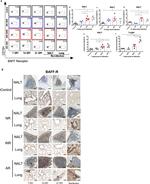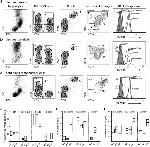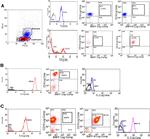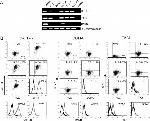Search Thermo Fisher Scientific
Invitrogen
CD268 (BAFF Receptor) Monoclonal Antibody (8A7), APC, eBioscience™
图: 1 / 9
CD268 (BAFF Receptor) Antibody (17-9117-42) in Flow
-Flow-20170216130641.jpg?time=20240507)








产品信息
17-9117-42
种属反应
已发表种属
宿主/亚型
分类
类型
克隆号
偶联物
激发/发射光谱
形式
浓度
纯化类型
保存液
内含物
保存条件
运输条件
RRID
产品详细信息
Description: The 8A7 monoclonal antibody reacts with the human BAFF receptor, also known as B lymphocyte stimulator (BLyS protein) receptor, which is expressed on B cells. The ligand for this receptor, BAFF (B cell-activating factor of the TNF family) is a B cell survival factor and regulates CD21/35 and CD23 expression. Interaction of this ligand with its receptor causes elevated CD21/35 and CD23 expression, whereas receptor blockade has been shown to down-modulate expression.
Applications Reported: This 8A7 antibody has been reported for use in flow cytometric analysis.
Applications Tested: This 8A7 antibody has been pre-titrated and tested by flow cytometric analysis of normal human peripheral blood cells. This can be used at 5 µL (0.015 µg) per test. A test is defined as the amount (µg) of antibody that will stain a cell sample in a final volume of 100 µL. Cell number should be determined empirically but can range from 10^5 to 10^8 cells/test.
Excitation: 633-647 nm; Emission: 660 nm; Laser: Red Laser.
Filtration: 0.2 µm post-manufacturing filtered.
靶标信息
Tumor necrosis factor receptor superfamily member 13C (TNFRSF13C), also known as BAFFR, is a protein in humans is encoded by the TNFRSF13C gene. The BAFFR gene is mapped to chromosome 22q13. 1-q13. 31. It has got 184 amino acid transmembrane protein which is 56% identical to the mouse protein. B cell-activating factor (BAFF) enhances B-cell survival in vitro and is a regulator of the peripheral B-cell population. BAFF plays a crucial role in B cell development and can function through receptors other than BCMA.
仅用于科研。不用于诊断过程。未经明确授权不得转售。
How to use the Panel Builder
Watch the video to learn how to use the Invitrogen Flow Cytometry Panel Builder to build your next flow cytometry panel in 5 easy steps.
生物信息学
蛋白别名: B cell-activating factor receptor; B-cell-activating factor receptor; BAFF receptor; BAFF-R; BLyS receptor 3; CD268; Tumor necrosis factor receptor superfamily member 13C; tumor necrosis factor receptor superfamily, member 13C
基因别名: BAFF-R; BAFFR; BR3; BROMIX; CD268; CVID4; prolixin; TNFRSF13C
UniProt ID: (Human) Q96RJ3
Entrez Gene ID: (Human) 115650

-Flow-20170216130641.jpg?time=20240507)


